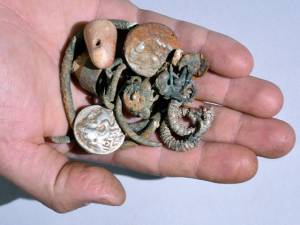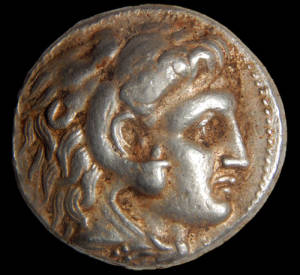
Some of the coins found in Galilee cave. (Shmuel Magal/IAA)
Hikers chanced upon ancient coins and valuables in a cave in northern Israel, which, experts say, rate among the most important archaeological discoveries.
A month after a group of divers accidently discovered an ancient treasure off the coast of Caesarea, Israeli hikers happened upon a cache of rare, 2,300-year-old coins as well as silver and bronze objects in a cave in northern Israel.
Officials of the Israel Antiquities Authority (IAA) believe it to be among the most important discoveries in the north in recent years. A significant amount of time for study will be necessary in order to crack the secrets of the cave, they say.
Two weeks ago, Reuven Zakai, his son Chen and their friend Lior Halony, members of the Israeli Caving Club, set out to make preliminary preparations for a visit to one of the largest and best-hidden stalactite caves in the north.
They lowered themselves down, wriggling through a narrow passage in the mouth of the cave, and then wandered and crawled throughout the different areas for several hours.
Chen, 21, says he forced his way into one of the narrow niches when he suddenly caught sight of shining objects – two ancient silver coins. It was later determined that the coins had been minted during the reign of Alexander the Great, who conquered the Land of Israel at the beginning of the Hellenistic period (late 4th century BCE).
Several pieces of silver jewelry were found alongside the coins, among them rings, bracelets and earrings, which were apparently concealed together inside a cloth pouch.
“The valuables might have been hidden in the cave by local residents who fled there during the period of governmental unrest stemming from the death of Alexander, a time when the Wars of the Diadochi broke out in Israel between Alexander’s heirs following his death,” archaeologists at the IAA opined. ”Presumably, the cache was hidden in the hope of better days, but today we know that whoever buried the treasure never returned to collect it.”

Active stalactites in the cave. (Shmuel Magal/IAA)
The hikers quickly realized the archaeological importance of their discovery and reported it to inspectors of the Unit for the Prevention of Antiquities Theft in the IAA. This past weekend, officials of the IAA entered the cave together with members of the Israeli Caving Club. The IAA inspectors were excited to discover evidence of human habitation that occurred in the cave over extended periods of time.
So far, they believe they have found artifacts that date back some 6,000 years to the Chalcolithic period up until approximately 2,300 years ago. Numerous pottery vessels were also discovered in the cave, some of which have fused with the limestone sediments and cannot be salvaged.
The IAA points out that the combination of a stalactite cave and archaeological finds is both fascinating and rare. “The finds in the cave will allow the researchers – archaeologists and geologists alike – to accurately date both the archaeological finds and the process of stalactite development,” the IAA added.
Exemplary Conduct

Silver coin of Alexander the Great found in the cave. (Shmuel Magal/IAA)
Amir Ganor, director of the Unit for the Prevention of Antiquities Robbery in the IAA, commended the hikers for their exemplary conduct.
“They understood the importance of the archaeological discovery and exhibited exemplary civic behavior by immediately bringing these impressive archaeological finds to the attention of the IAA,” Ganor stated. “After the gold treasure from Caesarea, this is the second time in the past month that citizens have reported significant archaeological finds, and we welcome this important trend. Thanks to these citizens’ awareness, researchers at the Israel Antiquities Authority will be able to expand the existing archaeological knowledge about the development of society and culture in the Land of Israel in antiquity.”
The Law of Antiquities, the IAA authorities emphasized, states that all antiquities belong to the state and that removing antiquities from their location, failing to report findings or selling or trading them is an offense punishable by up to five years in prison.
Officials at the IAA have decided to keep the exact location of the cave a secret for now because of the many hazards inside.
By: United with Israel Staff

Free Ebook: 10 Best Places to Visit in Israel
The Land of Israel has provided the backdrop for some of the most important events in human history. From the Old City in Jerusalem to the Sea of Galilee, people from all over the globe visit the Holy Land each year to take in the breathtaking scenery and inspiration of Israel. Now you can experience this beauty for yourself from the comforts of home and maybe plan a trip of your own to Israel. Get the free, exclusive eBook from United with Israel: The 10 Best Places to Visit in Israel.
Do You Love Israel? Make a Donation - Show Your Support!
Donate to vital charities that help protect Israeli citizens and inspire millions around the world to support Israel too!
Now more than ever, Israel needs your help to fight and win the war -- including on the battlefield of public opinion.
Antisemitism, anti-Israel bias and boycotts are out of control. Israel's enemies are inciting terror and violence against innocent Israelis and Jews around the world. Help us fight back!






















